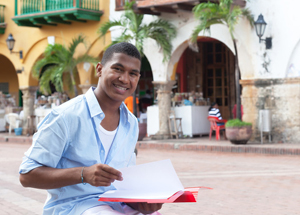
Imagine going into college knowing that, upon successful completion, your job awaits.
That’s the model of Cuba’s socialist higher education-workforce development partnership. Students rank their job interests, and the state assigns college majors according to student preference, student aptitude, and workforce need. Participants in the February 2018 Cuba Project research trip to Cuba found a country with a deep commitment to education as the heart of a nation’s social, political and economic life.
In Cuba, education is completely free, from grade school through doctoral programs, as long as the student is academically qualified, and support resources are readily available for students who need them.
“Education in Cuba is central to society and highly respected,” said AACRAO Deputy Director Melanie Gottlieb, lead of AACRAO’s Cuba Project. “There’s a national commitment to free education for everyone.”
Community, purpose, necessity
In contrast to the U.S., Cuba plans education in a centralized, intentional way. Rather than applying to a specific institution or program, students apply through a central application, and are typically routed through their local institutions.
“The Cuban culture is not very oriented toward mobility; students tend to stay close to home and serve their communities,” Gottlieb said.
Students rank their top ten interests and are generally assigned study areas and eventually careers in one of their areas of interest. The Planning Ministry, in conjunction with the Ministries of Labor and of Education, predict workforce demand, forecasting the professional and technical needs of the country over the next decade. This drives the courses offered and the specific number of spots available for admission in each major. While this forecasting has become increasingly difficult as the Cuban economy has been impacted by global market forces, it remains a driver in university admissions.
“We talked with a student who was in his third year studying to be a teacher,” Gottlieb said. “When he applied, teaching was third on his list -- studying law was first. But from a workforce development standpoint, the year he applied it had been decided that more teachers were needed so fewer applicants were accepted to study law.
“We asked him if he was upset when he wasn’t chosen to study law, and he said, ‘No, I like this. Why would I study something if I knew I wouldn’t have a job at the end of it?’”
Students do have the opportunity to return to school for retraining and to switch their career if they desire, and if the job demand is there. For example, as the tourism industry has risen, universities have developed education programs in tourism and many people have moved into those jobs.
Learn more
At AACRAO’s Fall Symposium, September 26-27, 2018, in Washington, D.C., researchers will share their insights and invite discussion on several topics related to Cuban higher education.
Over two days, participants will have an opportunity to attend a legislative session on Capitol Hill to advocate for further education exchange in Cuba, and will explore the pathways from secondary to post-secondary education and factors of student choice, domestic and international educational mobility, and the intersection of planned workforce development, economy, and globalization in Cuba.